Oral direct thrombin inhibitors or oral factor Xa inhibitors versus conventional anticoagulants for the treatment of deep vein thrombosis
- PMID: 37058421
- PMCID: PMC10105633
- DOI: 10.1002/14651858.CD010956.pub3
Oral direct thrombin inhibitors or oral factor Xa inhibitors versus conventional anticoagulants for the treatment of deep vein thrombosis
Abstract
Background: Deep vein thrombosis (DVT) is a condition in which a clot forms in the deep veins, most commonly of the leg. It occurs in approximately one in 1000 people. If left untreated, the clot can travel up to the lungs and cause a potentially life-threatening pulmonary embolism (PE). Previously, a DVT was treated with the anticoagulants heparin and vitamin K antagonists. However, two forms of direct oral anticoagulants (DOACs) have been developed: oral direct thrombin inhibitors (DTIs) and oral factor Xa inhibitors, which have characteristics that may be favourable compared to conventional treatment, including oral administration, a predictable effect, lack of frequent monitoring or dose adjustment and few known drug interactions. DOACs are now commonly being used for treating DVT: recent guidelines recommended DOACs over conventional anticoagulants for both DVT and PE treatment. This Cochrane Review was first published in 2015. It was the first systematic review to measure the effectiveness and safety of these drugs in the treatment of DVT. This is an update of the 2015 review. OBJECTIVES: To assess the effectiveness and safety of oral DTIs and oral factor Xa inhibitors versus conventional anticoagulants for the long-term treatment of DVT.
Search methods: The Cochrane Vascular Information Specialist searched the Cochrane Vascular Specialised Register, CENTRAL, MEDLINE, Embase and CINAHL databases and the World Health Organization International Clinical Trials Registry Platform and ClinicalTrials.gov trials registers to 1 March 2022.
Selection criteria: We included randomised controlled trials (RCTs) in which people with a DVT, confirmed by standard imaging techniques, were allocated to receive an oral DTI or an oral factor Xa inhibitor compared with conventional anticoagulation or compared with each other for the treatment of DVT. DATA COLLECTION AND ANALYSIS: We used standard Cochrane methods. Our primary outcomes were recurrent venous thromboembolism (VTE), recurrent DVT and PE. Secondary outcomes included all-cause mortality, major bleeding, post-thrombotic syndrome (PTS) and quality of life (QoL). We used GRADE to assess the certainty of evidence for each outcome.
Main results: We identified 10 new studies with 2950 participants for this update. In total, we included 21 RCTs involving 30,895 participants. Three studies investigated oral DTIs (two dabigatran and one ximelagatran), 17 investigated oral factor Xa inhibitors (eight rivaroxaban, five apixaban and four edoxaban) and one three-arm trial investigated both a DTI (dabigatran) and factor Xa inhibitor (rivaroxaban). Overall, the studies were of good methodological quality. Meta-analysis comparing DTIs to conventional anticoagulation showed no clear difference in the rate of recurrent VTE (odds ratio (OR) 1.17, 95% confidence interval (CI) 0.83 to 1.65; 3 studies, 5994 participants; moderate-certainty evidence), recurrent DVT (OR 1.11, 95% CI 0.74 to 1.66; 3 studies, 5994 participants; moderate-certainty evidence), fatal PE (OR 1.32, 95% CI 0.29 to 6.02; 3 studies, 5994 participants; moderate-certainty evidence), non-fatal PE (OR 1.29, 95% CI 0.64 to 2.59; 3 studies, 5994 participants; moderate-certainty evidence) or all-cause mortality (OR 0.66, 95% CI 0.41 to 1.08; 1 study, 2489 participants; moderate-certainty evidence). DTIs reduced the rate of major bleeding (OR 0.58, 95% CI 0.38 to 0.89; 3 studies, 5994 participants; high-certainty evidence). For oral factor Xa inhibitors compared with conventional anticoagulation, meta-analysis demonstrated no clear difference in recurrent VTE (OR 0.85, 95% CI 0.71 to 1.01; 13 studies, 17,505 participants; moderate-certainty evidence), recurrent DVT (OR 0.70, 95% CI 0.49 to 1.01; 9 studies, 16,439 participants; moderate-certainty evidence), fatal PE (OR 1.18, 95% CI 0.69 to 2.02; 6 studies, 15,082 participants; moderate-certainty evidence), non-fatal PE (OR 0.93, 95% CI 0.68 to 1.27; 7 studies, 15,166 participants; moderate-certainty evidence) or all-cause mortality (OR 0.87, 95% CI 0.67 to 1.14; 9 studies, 10,770 participants; moderate-certainty evidence). Meta-analysis showed a reduced rate of major bleeding with oral factor Xa inhibitors compared with conventional anticoagulation (OR 0.63, 95% CI 0.45 to 0.89; 17 studies, 18,066 participants; high-certainty evidence). AUTHORS' CONCLUSIONS: The current review suggests that DOACs may be superior to conventional therapy in terms of safety (major bleeding), and are probably equivalent in terms of efficacy. There is probably little or no difference between DOACs and conventional anticoagulation in the prevention of recurrent VTE, recurrent DVT, pulmonary embolism and all-cause mortality. DOACs reduced the rate of major bleeding compared to conventional anticoagulation. The certainty of evidence was moderate or high.
Copyright © 2023 The Cochrane Collaboration. Published by John Wiley & Sons, Ltd.
Conflict of interest statement
XW: none known. YM: none known. XH: none known. ML: none known. JL: none known. JT: none known. QW: none known. PY: none known. JFL: none known. PX: none known. KY: none known. LY: none known.
Figures




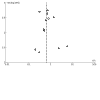
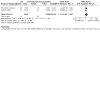


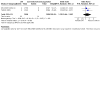
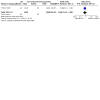


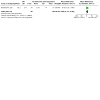



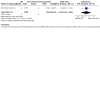



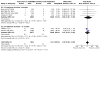


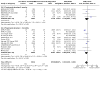
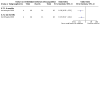





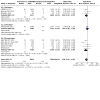


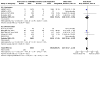


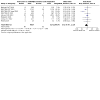
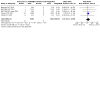




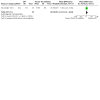
Update of
-
Oral direct thrombin inhibitors or oral factor Xa inhibitors for the treatment of deep vein thrombosis.Cochrane Database Syst Rev. 2015 Jun 30;(6):CD010956. doi: 10.1002/14651858.CD010956.pub2. Cochrane Database Syst Rev. 2015. Update in: Cochrane Database Syst Rev. 2023 Apr 14;4:CD010956. doi: 10.1002/14651858.CD010956.pub3. PMID: 26123214 Updated.
Comment in
-
In DVT, oral DTIs and factor Xa inhibitors reduce major bleeding but not recurrent VTE vs. conventional anticoagulants.Ann Intern Med. 2023 Aug;176(8):JC92. doi: 10.7326/J23-0053. Epub 2023 Aug 1. Ann Intern Med. 2023. PMID: 37523702
-
Direct Oral Anticoagulants vs. Conventional Anticoagulants for the Treatment of VTE.Am Fam Physician. 2024 Mar;109(3):210. Am Fam Physician. 2024. PMID: 38574209 No abstract available.
References
References to studies included in this review
AMPLIFY 2013 {published data only}
-
- Agnelli G, Buller H, Masiukiewicz UP. Apixaban for the treatment of symptomatic deep-vein thrombosis and pulmonary embolism: a randomized, double-blind trial (AMPLIFY). Journal of Thrombosis and Haemostasis 2013;11:18.
-
- Agnelli G, Buller HR, Cohen A, Curto D, Gallus AS, Johnson M, et al. Oral apixaban for the treatment of acute venous thromboembolism. New England Journal of Medicine 2013;369:799-808. - PubMed
-
- Agnelli G, Buller HR, Cohen A, Curto M, Gallus AS, Pak R, et al. Apixaban for the treatment of venous thromboembolism in cancer patients: data from the AMPLIFY trial. Canadian Journal of Cardiology 2014;30(10 Suppl 1):S278.
-
- Agnelli G, Buller HR, Cohen A, Gallus AS, Lee TC, Pak R, et al. Oral apixaban for the treatment of venous thromboembolism in cancer patients: results from the AMPLIFY trial. Journal of Thrombosis and Haemostasis 2015;13(12):2187-91. - PubMed
-
- Agnelli G. Apixaban was non-inferior to enoxaparin plus warfarin in patients with acute venous thromboembolism. Annals of Internal Medicine 2013;159(8):JC2. - PubMed
AMPLIFY‐J 2015 {published data only}
-
- Nakamura M, Nishikawa M, Komuro I, Kitajima I, Uetsuka Y, Yamagami T, et al. Apixaban for the treatment of Japanese subjects with acute venous thromboembolism (AMPLIFY-J Study). Circulation 2015;79(6):1230–36. - PubMed
Botticelli DVT 2008 {published data only}
-
- Barrett YC, Wang J, Knabb R, Mohan P. Apixaban decreases coagulation activity in patients with acute deep-vein thrombosis. Thrombosis and Haemostasis 2011;105:181-9. - PubMed
-
- Botticelli Investigators Writing Committee, Buller H, Deitchman D, Prins M, Segers A. Efficacy and safety of the oral direct factor Xa inhibitor apixaban for symptomatic deep vein thrombosis. The Botticelli DVT dose-ranging study. Journal of Thrombosis and Haemostasis 2008;6:1313-8. - PubMed
-
- Buller HR. A dose finding study of the oral direct factor Xa inhibitor apixaban in the treatment of patients with acute symptomatic deep vein thrombosis - the Botticelli Investigators. Journal of Thrombosis and Haemostasis 2007;5 (Suppl 2):O-S-003. - PubMed
-
- NCT00252005. Oral direct factor Xa-inhibitor apixaban in patients with acute symptomatic deep-vein thrombosis - the Botticelli DVT study. clinicaltrials.gov/ct/show/NCT00252005?order=1 (first received 11 November 2005).
Caravaggio 2020 {published data only}
-
- Ageno W, Vedovati MC, Cohen A, Huisman M, Bauersachs R, Gussoni G, et al. Bleeding with apixaban and dalteparin in patients with cancer-associated venous thromboembolism: results from the Caravaggio study. Thrombosis and Haemostasis 2021;121(5):616-24. - PubMed
-
- Agnelli G, Becattini C, Bauersachs R, Brenner B, Campanini M, Cohen A, et al. Apixaban versus dalteparin for the treatment of acute venous thromboembolism in patients with cancer: the Caravaggio study. Thrombosis and Haemostasis 2018;118(9):1668-78. - PubMed
-
- Agnelli G, Becattini C, Meyer G, Muoz A, Verso M. Apixaban for the treatment of venous thromboembolism associated with cancer. New England Journal of Medicine 2020;382(17):1599-607. - PubMed
-
- Agnelli G, Muoz A, Franco L, Mahé I, Brenner B, Connors JM, et al. Apixaban and dalteparin for the treatment of venous thromboembolism in patients with different sites of cancer. Thrombosis and Haemostasis 2022;122(5):796-807. - PubMed
-
- Becattini C, Bauersachs R, Maraziti G, Bertoletti L, Cohen A, Connors JM, et al. Renal function and clinical outcome of patients with cancer-associated venous thromboembolism randomized to receive apixaban or dalteparin. Results from the Caravaggio trial. Haematologica 2021;107(7):1567-76. - PMC - PubMed
de Athayde 2019 {published data only}
-
- NCT02704598. Comparison between xarelto versus warfarin in the recanalization rate of deep venous thrombosis in patients legs. (DVT). clinicaltrials.gov/ct2/show/NCT02704598 (first received 10 March 2016).
-
- Athayde Soares R, Matielo MF, Brochado Neto FC, Almeida RD, Sacilotto R. LEV 2. Comparison of the recanalization rate and post-thrombotic syndrome in patients with deep venous thrombosis treated with rivaroxaban or warfarin. Journal of Vascular Surgery 2019;70(5):e169-e170. - PubMed
-
- Athayde Soares R, Matielo MF, Brochado Neto FC, Nogueira MP, Almeida RD, Sacilotto R. Comparison of the recanalization rate and postthrombotic syndrome in patients with deep venous thrombosis treated with rivaroxaban or warfarin. Surgery 2019;166(6):1076-83. - PubMed
EINSTEIN‐DVT 2010 {published data only}
-
- Bamber L, Wang MY, Prins MH, Ciniglio C, Bauersachs R, Lensing AW, et al. Patient-reported treatment satisfaction with oral rivaroxaban versus standard therapy in the treatment of acute symptomatic deep-vein thrombosis. Thrombosis and Haemostasis 2013;110(4):732-41. - PubMed
-
- Bauersachs R, Lensing AW, Pap A, Decousus H. No need for a rivaroxaban dose reduction in renally impaired patients with symptomatic venous thromboembolism. Journal of Thrombosis and Haemostasis 2013;11(Suppl 2):30-1.
-
- Bistervels I, Gebel M, Lensing A, Middeldorp S, Coppens M. Effect of polypharmacy on bleeding of rivaroxaban versus vitamin K antagonist for treatment of venous thromboembolism. Research and Practice in Thrombosis and Haemostasis 2019;3:798‐9.
-
- Bookhart BK, Haskell L, Bamber L, Wang M, Schein J, Mody SH. Length of stay and economic consequences with rivaroxaban vs enoxaparin/vitamin K antagonist in patients with DVT and PE: findings from the North American EINSTEIN clinical trial program. Journal of Medical Economics 2014;17(10):691-5. - PubMed
-
- Buller HR. Oral rivaroxaban for the acute and continued treatment of symptomatic venous thromboembolism. The Einstein-DVT and Einstein-Extension study. Blood 2010;116(21):187.
EINSTEIN‐DVT dose 2008 {published data only}
-
- Buller H, Darius H. EINSTEIN DVT: oral rivaroxaban versus standard therapy in the initial treatment of symptomatic deep vein thrombosis and long-term prevention of recurrent venous thromboembolism. escardio.org/The-ESC/Press-Office/Press-releases/EINSTEIN-DVT-Oral-rivar... (accessed 19 October 2022).
-
- Buller HR, Agnelli G. Once- or twice-daily rivaroxaban for the treatment of proximal deep vein thrombosis: similar efficacy and safety to standard therapy in dose-ranging studies. Blood 2006;108(11 Part 1):172-3.
-
- Buller HR, Lensing AW, Prins MH, Agnelli G, Cohen A, Gallus AS, et al. A dose-ranging study evaluating once-daily oral administration of the factor Xa inhibitor rivaroxaban in the treatment of patients with acute symptomatic deep vein thrombosis: the Einstein-DVT dose-ranging study. Blood 2008;112(6):2242-7. - PubMed
-
- NCT00395772. Once-daily oral direct factor Xa inhibitor BAY59-7939 in patients with acute symptomatic deep-vein thrombosis. clinicaltrials.gov/ct2/show/NCT00395772?term=einstein-dvt&rank=2 (first received 3 November 2006).
EINSTEIN‐PE 2012 {published data only}
-
- Buller HR, Prins MH, Lensin AW, Decousus H, Jacobson BF, Minar E, et al. Oral rivaroxaban for the treatment of symptomatic pulmonary embolism. New England Journal of Medicine 2012;366:1287-97. - PubMed
-
- NCT00439777. Oral direct factor Xa inhibitor rivaroxaban in patients with acute symptomatic pulmonary embolism with or without symptomatic deep-vein thrombosis: Einstein-PE evaluation, 2008. clinicaltrials.gov/ct2/show/NCT00439777?term=NCT00439777&rank=1 (first received 26 February 2007).
-
- Prins M, Bamber L, Cano S, Wang M, Lensing AW, Bauersachs R. Patient-reported treatment satisfaction with oral rivaroxaban versus standard therapy in the treatment of acute symptomatic pulmonary embolism. Blood 2012;120(21):1163.
-
- Prins MH, Bamber L, Cano SJ, Wang MY, Erkens P, Bauersachs R, et al. Patient-reported treatment satisfaction with oral rivaroxaban versus standard therapy in the treatment of pulmonary embolism; results from the EINSTEIN PE trial. Thrombosis Research 2015;135(2):281-8. - PubMed
eTRIS 2016 {published data only}
-
- Piazza G, Mani V, Goldhaber SZ, Grosso MA, Mercuri M, Lanz HJ, et al. Magnetic resonance venography to assess thrombus resolution with edoxaban monotherapy versus parenteral anticoagulation/warfarin for symptomatic deep vein thrombosis: a multicenter feasibility study. Vascular Medicine 2016;21(4):361-8. - PMC - PubMed
-
- Piazza G, Mani V, Grosso M, Mercuri M, Lanz H, Schussler S, et al. A randomized, open-label, multicenter study of the efficacy and safety of edoxaban monotherapy versus low-molecular weight heparin/warfarin in patients with symptomatic deep vein thrombosis-edoxaban thrombus reduction imaging study (etris). Circulation 2014;130:A12074.
Farhan 2019 {published data only}
-
- Farhan A, Bukhari M, Umar J, Raza MA. Oral rivaroxaban in symptomatic deep vein thrombosis. Journal of the College of Physicians and Surgeons Pakistan 2019;29(9):814-8. - PubMed
Hokusai‐VTE 2013 {published data only}
-
- Bistervels I, Bavalia R, Boersma W, Meijer K, Verhamme P, Ten Cate-Hoek AJ, et al. Hokusai Post-DVT Study: a follow-up study on long-term outcomes of deep vein thrombosis in patients treated with edoxaban vs warfarin. Research and Practice in Thrombosis and Haemostasis 2020;4(Suppl 1):PB2207.
-
- Brekelmans MP, Ageno W, Beenen LF, Brenner B, Buller HR, Chen CZ, et al. Recurrent venous thromboembolism in patients with pulmonary embolism and right ventricular dysfunction: a post-hoc analysis of the Hokusai-VTE study. Lancet Haematology 2016;3(9):e437-45. - PubMed
-
- Brekelmans MP, Bleker SM, Bauersachs R, Boda Z, Büller HR, Choi Y, et al. Clinical impact and course of major bleeding with edoxaban versus vitamin K antagonists. Thrombosis and Haemostasis 2016;116(1):155-61. - PubMed
-
- Di Nisio M, Van Es N, Carrier M, Wang TF, Garcia D, Segers A, et al. Extended treatment with edoxaban in cancer patients with venous thromboembolism: a post-hoc analysis of the Hokusai-VTE Cancer study. Journal of Thrombosis and Haemostasis 2019;17:1866–74. - PubMed
-
- EUCTR2009-014290-40-SE. A phase 3, randomized, double-blind, double-dummy, parallel group, multi-center, multi-national study for evaluation of efficacy and safety of DU-176b versus warfarin in subjects with atrial fibrillation - effective anticoagulation with factor Xa next generation in atrial fibrillation (ENGAGE-AF TIMI-48). trialsearch.who.int/?trialid=EUCTR2009-014290-40-SE (first received 30 November 2009).
Hokusai VTE Cancer 2018 {published data only}
-
- Amaya N, Uzui H, Hisazaki K, Hasegwa K, Kaseno K, Tada H. Edoxaban normalizes the elevated D-dimer levels potently and promptly in patients with venous thromboembolisms: a comparison with traditional anticoagulant therapy. European Heart Journal 2016;37:278.
-
- Bosch FT, Van Es N, Di Nisio M, Carrier M, Segers A, Grosso MA, et al. The Ottawa score does not predict recurrent venous thromboembolism in cancer patients: results from the Hokusai-VTE cancer study. Research and Practice in Thrombosis and Haemostasis 2019;3(S1):717-8.
-
- Mulder FI, Van Es N, Kraaijpoel N, Di Nisio M, Carrier M, Garcia D, et al. Efficacy and safety of edoxaban in clinically relevant subgroups: results from the Hokusai VTE Cancer randomized trial. Thrombosis Research 2018;164:S194.
J‐EINSTEIN DVT and PE 2015 {published data only}
-
- Matsuo H, Prins M, Lensing AW, Fujinuma EW, Miyamoto Y, Kajikawa M. Shortened length of hospital stay with rivaroxaban in patients with symptomatic venous thromboembolism in Japan: the J-EINSTEIN pulmonary embolism and deep vein thrombosis program. Current Medical Research and Opinion 2015;31(6):1057-61. - PubMed
-
- NCT01516814. Venous thromboembolism (VTE) treatment study in Japanese pulmonary embolism (PE) patients. clinicaltrials.gov/ct2/show/NCT01516814 (first received 25 January 2012).
Mokadem 2021 {published data only}
-
- Mokadem ME, Hassan A, Algaby AZ. Efficacy and safety of apixaban in patients with active malignancy and acute deep venous thrombosis. Vascular 2021;29(5):745-50. - PubMed
-
- NCT04462003. Efficacy of apixaban in malignancy with deep venous thrombosis (DVT). clinicaltrials.gov/ct2/show/NCT04462003 (first received 3 July 2019).
ODIXa‐DVT 2007 {published data only}
-
- Agnelli G, Gallus A, Goldhaber SZ, Haas S, Huisman MV, Hull RD, et al. Treatment of proximal deep-vein thrombosis with the oral direct factor Xa inhibitor rivaroxaban (BAY 59-7939): the ODIXa-DVT (Oral Direct Factor Xa Inhibitor BAT 59-7939 in patients with acute symptomatic deep-vein thrombosis) study. Circulation 2007;116:180-7. - PubMed
Ohmori 2019 {published data only}
-
- Ohmori H, Nakamura M, Kada A, Saito AM, Sanayama Y, Shinagawa T, et al. Multicenter, open-label, randomized controlled trial of warfarin and edoxaban tosilate hydrate for the treatment of deep vein thrombosis in persons with severe motor intellectual disabilities. Kurume Medical Journal 2018;65(1):11-6. - PubMed
PRAIS 2019 {published data only}
-
- Min SK, Ahn S, Park KH, Kang JM, Kim JY. Prevention of recurrence after thrombolysis in acute iliofemoral venous thrombosis with rivaroxaban (Prais Study): a prospective, randomized, open label, multicenter trial. European Journal of Vascular and Endovascular Surgery 2019;58(6):e516.
-
- NCT01986192. Prevention of recurrence after thrombolysis in acute iliofemoral venous thrombosis (PRAIS) study. clinicaltrials.gov/show/NCT01986192 (first received 18 November 2013).
RE‐COVER 2009 {published data only}
-
- Goldhaber SZ, Schellong S, Kakkar A, Eriksson H, Feuring M, Kreuzer J, et al. Treatment of acute pulmonary embolism with dabigatran versus warfarin. A pooled analysis of data from RE-COVER and RE-COVER II. Thrombosis and Haemostasis 2016;116(4):714-21. - PubMed
-
- NCT00291330. Efficacy and safety of dabigatran compared to warfarin for 6 month treatment of acute symptomatic venous thromboembolism (RE-COVER I). clinicaltrials.gov/ct/show/NCT00291330 (first received 14 February 2006).
-
- Schulman S, Eriksson H, Goldhaber S, Kakkar AK, Kearon C, Kvamme AM, et al. Dabigatran or warfarin for extended maintenance therapy of venous thromboembolism. Journal of Thrombosis and Haemostasis 2011;9(Suppl 2):731-2.
-
- Schulman S, Eriksson H, Goldhaber SZ, Kakkar A, Kearon C, Mismetti P, et al. Safety of dabigatran vs. warfarin for acute venous thromboembolism: pooled analyses of RE-COVER and RE-COVER II. Journal of Thrombosis and Haemostasis 2013;11:225-6.
-
- Schulman S, Eriksson H, Goldhaber SZ, Kakkar A, Kearon C, Schellong SM, et al. Influence of age on the efficacy and safety of dabigatran versus warfarin for the treatment of acute venous thromboembolism: a pooled analysis of RE-COVER and RE-COVER II. Blood 2013;122:2375.
RE‐COVER II 2014 {published data only}
-
- Goldhaber SZ, Schellong S, Kakkar A, Eriksson H, Feuring M, Kreuzer J, et al. Treatment of acute pulmonary embolism with dabigatran versus warfarin. A pooled analysis of data from RE-COVER and RE-COVER II. Thrombosis and Haemostasis 2016;116(4):714-21. - PubMed
-
- NCT00680186. Phase III study testing efficacy & safety of oral dabigatran etexilate vs warfarin for 6 m treatment for acute symp venous thromboembolism (VTE) (RE-COVER II). clinicaltrials.gov/ct2/show/NCT00680186 (first received 20 May 2008).
-
- Schulman S, Eriksson H, Goldhaber SZ, Kakkar A, Kearon C, Mismetti P, et al. Safety of dabigatran vs. warfarin for acute venous thromboembolism: pooled analyses of RE-COVER and RE-COVER II. Journal of Thrombosis and Haemostasis 2013;11:225-6.
-
- Schulman S, Eriksson H, Goldhaber SZ, Kakkar A, Kearon C, Schellong SM, et al. Influence of age on the efficacy and safety of dabigatran versus warfarin for the treatment of acute venous thromboembolism: a pooled analysis of RE-COVER and RE-COVER II. Blood 2013;122:2375.
-
- Schulman S, Eriksson H, Goldhaber SZ, Kakkar A, Kearon C, Schellong SM, et al. Influence of concomitant NSAID or ASA on the efficacy and safety of dabigatran versus warfarin for the treatment of acute venous thromboembolism: a pooled analysis from RE-COVER and RECOVER II. Blood 2013;122(21):212.
Sukovatykh 2017 {published data only}
-
- Sukovatykh BS, Sereditskiĭ AV, Muradian VF, Belikov LN, Gerasimova OF. Results of administering oral anticoagulants for treatment of patients with venous thromboembolic complications. Angiologiia i sosudistaia khirurgiia [Angiology and Vascular Surgery] 2017;23(2):82. - PubMed
THRIVE 2005 {published data only}
-
- Fiessinger JN, Huisman MV, Davidson BL, Bounameaux H, Francis CW, Eriksson H, et al. Ximelagatran vs low-molecular-weight heparin and warfarin for the treatment of deep vein thrombosis: a randomised trial. JAMA 2005;293(6):681-9. - PubMed
-
- Francis CW, Ginsberg JS, Berkowitz SD, Bounameaux H, Davidson BL, Eriksson H, et al. Efficacy and safety of the oral direct thrombin inhibitor ximelagatran compared with current therapy for acute, symptomatic deep vein thrombosis, with or without pulmonary embolus: the THRIVE treatment study. Blood 2003;102(11):Abstract 7.
-
- Harenberg J, Ingrid J, Tivadar F. Treatment of venous thromboembolism with the oral thrombin inhibitor, ximelagatran. Israel Medical Association Journal 2002;4(11):1003-5. - PubMed
-
- Harenberg J, Joerg I, Weiss C. Incidence of recurrent venous thromboembolism of patients after termination of treatment with ximelagatran. European Journal of Clinical Pharmacology 2006;62(3):173-7. - PubMed
-
- Harenberg J, Jorg I, Weiss C, Harenberg J, Jorg I, Weiss C. Observations of alanine aminotransferase and aspartate aminotransferase in THRIVE studies treated orally with ximelagatran. International Journal of Toxicology 2006;25(3):165-9. - PubMed
References to studies excluded from this review
ADAM VTE trial 2020 {published data only}
-
- McBane RD 2nd, Loprinzi CL, Ashrani A, Perez-Botero J, Ferre RA, Henkin S, et al. Apixaban and dalteparin in active malignancy associated venous thromboembolism. The ADAM VTE trial. Thrombosis and Haemostasis 2017;117(10):1952-61. - PubMed
-
- McBane RD 2nd, Wysokinski WE, Le-Rademacher JG, Zemla T, Ashrani A, Tafur A, et al. Apixaban and dalteparin in active malignancy-associated venous thromboembolism: The ADAM VTE trial. Thrombosis and Haemostasis 2020;18(2):411-21. - PubMed
-
- NCT02585713. Apixaban or dalteparin in reducing blood clots in patients with cancer related venous thromboembolism. clinicaltrials.gov/ct2/show/NCT02585713 (first received 23 October 2015).
AMPLIFY Extended Study 2013 {published data only}
-
- Agnelli G, Buller HR, Cohen A, Curto M, Gallus AS, Johnson M, et al. Apixaban for extended treatment of venous thromboembolism. New England Journal of Medicine 2013;368(8):699-708. - PubMed
-
- Agnelli G, Buller HR, Cohen A, Curto M, Gallus AS, Johnson MR, et al. Two doses of apixaban for the extended treatment of venous thromboembolism. Blood 2012;120:LBA-1.
Borsi 2021 {published data only}
-
- Borsi SH, Raji H, Dargahi MM, Nokhostin F, Kargaran A. Rivaroxaban versus enoxaparin for treatment of patients with nonhematologic cancer with venous thromboembolism: a randomized clinical trial. Tehran University Medical Journal 2021;79(4):281-9.
CASTA DIVA Trial 2022 {published data only}
-
- NCT02746185. Cancer associated thrombosis, a pilot treatment study using rivaroxaban (CASTA-DIVA). clinicaltrials.gov/ct2/show/NCT02746185 (first received 21 April 2016).
-
- Planquette B, Bertoletti L, Charles-Nelson A, Laporte S, Grange C, Mahé I, et al. Rivaroxaban vs dalteparin in cancer-associated thromboembolism: a randomized trial. Chest 2022;161(3):781-90. - PubMed
COBRRA 2017 {published data only}
-
- Castellucci LA, Hogg K, Chiang P, Wu CM, Templier GL, Gal GL, et al. Comparison of bleeding risk between rivaroxaban and apixaban: a pilot feasibility study. Blood 2017;130:1108.
CONKO‐011 study 2015 {published data only}
-
- EUCTR2015-001478-16-DE. The role of rivaroxaban in the treatment of tumor patients with thrombosis. trialsearch.who.int/Trial2.aspx?TrialID=EUCTR2015-001478-16-DE (first received 9 September 2015).
-
- NCT02583191. Rivaroxaban in the treatment of venous thromboembolism (VTE) in cancer patients. clinicaltrials.gov/ct2/show/NCT02583191 (first received 22 October 2015).
-
- Riess H, Sinn M, Kreher S. CONKO-011: evaluation of patient satisfaction with the treatment of acute venous thromboembolism with rivaroxaban or low molecular weight heparin in cancer patients. A randomized phase III study. Deutsche Medizinische Wochenschrift 2015;140(Suppl 1):S22. - PubMed
-
- Riess H, Sinn M, Lohneis A, Hellmann M, Striefler J, Südhoff T, et al. Improved patient-reported treatment satisfaction with rivaroxaban as compared to low molecular weight heparins for cancer patients with acute venous thromboembolism – results from the CONKO-011 trial. Research and Practice in Thrombosis and Haemostasis 2021;5(Suppl 2):LPB0041.
-
- Sinn M, Juhling A, Hellmann M, Omar M, Sudhoff T, Stahl M, et al. Patient-reported treatment satisfaction with Rivaroxaban in cancer patients with acute venous thromboembolism - results from the CONKO-011 trial. Oncology Research and Treatment 2021;44(Suppl 2):276-7.
DIVERSITY 2021 {published data only}
-
- Albisetti M, Biss B, Bomgaars L, Brandão LR, Brueckmann M, Chalmers E, et al. Design and rationale for the DIVERSITY study: an open-label, randomized study of dabigatran etexilate for pediatric venous thromboembolism. Research and Practice in Thrombosis and Haemostasis 2018;2(2):347-56. - PMC - PubMed
-
- Albisetti M, Brandão L, Bomgaars L, Chalmers E, Luciani M, Mitchell L, et al. Efficacy and safety of dabigatran etexilate for treatment of venous thromboembolism in paediatric patients - results of the DIVERSITY trial. ISTH Academy 2019:OC 57.3.
-
- Albisetti M, Tartakovsky I, Halton J, Bomgaars L, Chalmers E, Mitchell L, et al. Efficacy and safety of dabigatran in the treatment and secondary prevention of venous thromboembolism in children with central line or implantable device–related thrombosis. Research and Practice in Thrombosis and Haemostasis 2021;5(Suppl 2):OC 69.2.
-
- Brandão L, Tartakovsky I, Halton J, Bomgaars L, Chalmers E, Mitchell L, et al. Efficacy and safety of dabigatran in the treatment and secondary prevention of venous thromboembolism in children with cerebral venous and sinus thrombosis. Research and Practice in Thrombosis and Haemostasis 2021;5(Suppl 2):PB0787.
-
- EUCTR2013-002114-12. Open label study comparing efficacy and safety of dabigatran etexilate to standard of care in paediatric patients with VTE. trialsearch.who.int/?TrialID=EUCTR2013%E2%80%90002114%E2%80%9012%E2%80%9... (first received 18 Feburary 2014).
EINSTEIN‐CHOICE 2017 {published data only}
-
- Prandoni P, Lensing AW, Prins MH, Gebel M, Pap AF, Homering M, et al. Benefits and risks of extended treatment of venous thromboembolism with rivaroxaban or with aspirin. Thrombosis Research 2018;168:121-9. - PubMed
-
- Weitz JI, Lensing AW, Prins MH, Bauersachs R, Beyer-Westendorf J, Bounameaux H, et al. Rivaroxaban or aspirin for extended treatment of venous thromboembolism. New England Journal of Medicine 2017;376(13):1211-22. - PubMed
EINSTEIN‐Jr 2020 {published data only}
-
- Male C, Lensing AW, Palumbo JS, Kumar R, Nurmeev I, Hege K, et al. Rivaroxaban compared with standard anticoagulants for the treatment of acute venous thromboembolism in children: a randomised, controlled, phase 3 trial. Lancet Haematology 2020;7(1):e18-e27. - PubMed
-
- NCT01684423. Oral rivaroxaban in children with venous thrombosis (EINSTEIN Junior). clinicaltrials.gov/show/NCT01684423 (first received 13 September 2012).
-
- NCT02234843. EINSTEIN Junior: oral rivaroxaban in children with venous thrombosis. clinicaltrials.gov/ct2/show/NCT02234843 (first received 9 September 2014).
-
- NCT02309411. EINSTEIN Junior phase II: oral rivaroxaban in young children with venous thrombosis (EINSTEIN Jr). hclinicaltrials.gov/ct2/show/NCT02309411 (first received 5 December 2014).
Peacock 2018 {published data only}
-
- NCT02584660. A study of rivaroxaban for early discharge of low risk pulmonary embolism from the emergency department. clinicaltrials.gov/ct2/show/NCT02584660 (first received 22 October 2015).
-
- Peacock W, Diercks D, Francis S, Kabrhel C, Keay C, Kline J, et al. Multicenter trial of rivaroxaban for early discharge of pulmonary embolism from the emergency department. Annals of Emergency Medicine 2017;70(4):S29-S30.
PRIORITY 2022 {published data only}
-
- Kim JH, Yoo C, Seo S, Jeong JH, Ryoo BY, Kim KP, et al. A phase II study to compare the safety and efficacy of direct oral anticoagulants versus subcutaneous dalteparin for cancer-associated venous thromboembolism in patients with advanced upper gastrointestinal, hepatobiliary and pancreatic cancer: PRIORITY. Cancers 2022;14(3):559. - PMC - PubMed
-
- NCT03139487. A randomized phase II open label study to compare the safety and efficacy of subcutaneous dalteparin versus direct oral anticoagulants for cancer-associated venous thromboembolism. clinicaltrials.gov/ct2/show/NCT03139487 (first received 4 May 2017).
REMEDY 2013 {published data only}
-
- Liem TK, DeLoughery TG. Randomised controlled trial: extended-duration dabigatran is non-inferior to warfarin and more effective than placebo for symptomatic VTE. Evidence Based Medicine 2014;19(1):29. - PubMed
-
- Schulman S, Kearon C, Kakkar AK, Schellong S, Eriksson H, Baanstra A, et al. Extended use of dabigatran, warfarin, or placebo in venous thromboembolism. New England Journal of Medicine 2013;368:709-18. - PubMed
RE‐SONATE 2013 {published data only}
-
- Schulman S, Baanstra D, Eriksson H, Goldhaber S, Kakkar A, Kearon C, et al. Dabigatran vs. placebo for extended maintenance therapy of venous thromboembolism. Journal of Thrombosis and Haemostasis 2011;9(Suppl 2):22.
-
- Schulman S, Baanstra D, Eriksson H, Goldhaber SZ, Kakkar A, Kearon C, et al. Benefit of extended maintenance therapy for venous thromboembolism with dabigatran etexilate is maintained over 1 year of post-treatment follow-up. Blood 2012;120(21):Abstract 332.
-
- Schulman S, Kearon C, Kakkar AK, Schellong S, Eriksson H, Baanstra D, et al. Extended use of dabigatran, warfarin, or placebo in venous thromboembolism. New England Journal of Medicine 2013;368(8):709-18. - PubMed
SELECT‐D 2018 {published data only}
-
- EUCTR2012-005589-37-GB. Anticoagulation therapy in selected cancer patients at risk of recurrence of venous thromboembolism. trialsearch.who.int/Trial2.aspx?TrialID=EUCTR2012-005589-37-GB (first received 18 February 2013).
-
- Young A, Dunn J, Chapman O, Grumett J, Marshall A, Phillips J, et al. SELECT-D: anticoagulation therapy in selected cancer patients at risk of recurrence of venous thromboembolism. Journal of Clinical Oncology 2014;32(Suppl 15):TPS9661-TPS9661. - PubMed
-
- Young A, Marshall A, Thirlwall J, Hill C, Hale D, Dunn J, et al. Anticoagulation therapy in selected cancer patients at risk of recurrence of venous thromboembolism: results of the select-D™ pilot trial. Blood 2017;130:625.
-
- Young A, Phillips J, Hancocks H, Hill C, Joshi N, Marshall A, et al. Anticoagulation therapy in selected cancer patients at risk of recurrence of venous thromboembolism (OC-11). Thrombosis Research 2016;140(Suppl 1):S172-3. - PubMed
-
- Young AM, Marshall A, Thirlwall J, Chapman O, Lokare A, Hill C, et al. Comparison of an oral factor Xa inhibitor with low molecular weight heparin in patients with cancer with venous thromboembolism: results of a randomized trial (SELECT-D). Journal of Clinical Oncology 2018;36(20):2017-23. - PubMed
THRIVE I 2003 {published data only}
-
- Eriksson H, Wåhlander K, Gustafsson D, Welin LT, Frison L, Schulman S, et al. A randomized, controlled, dose-guiding study of the oral direct thrombin inhibitor ximelagatran compared with standard therapy for the treatment of acute deep vein thrombosis: THRIVE I. Journal of Thrombosis and Haemostasis 2003;1:41-7. - PubMed
THRIVE III 2003 {published data only}
-
- Eriksson H, Lundstrom T, Wahlander K, Clason SB, Schulman S. Prognostic factors for recurrence of venous thromboembolism (VTE) or bleeding during long-term secondary prevention of VTE with ximelagatran. Thrombosis and Haemostasis 2005;94(3):522-7. - PubMed
-
- Eriksson H, Wahlander K, Lundstrom T, Billing CS, Schulman S. Extended secondary prevention with the oral direct thrombin inhibitor ximelagatran for 18 months after 6 months of anticoagulation in patients with venous thromboembolism: a randomized, placebo-controlled trial. Blood 2002;100(Suppl):81a.
-
- Schulman S, Lundstrom T, Walander K, Billing CS, Eriksson H. Ximelagatran for the secondary prevention of venous thromboembolism: a complementary follow-up analysis of the THRIVE III study. Thrombosis and Haemostasis 2005;94(4):820-4. - PubMed
-
- Schulman S, Wahlander K, Lundstrom T, Clason SB, Eriksson H, THRIVE III Investigators. Secondary prevention of venous thromboembolism with the oral direct thrombin inhibitor ximelagatran. New England Journal of Medicine 2003;349(18):1713-21. - PubMed
References to studies awaiting assessment
NCT01780987 {published data only}
-
- NCT01780987. A study to evaluate safety and efficacy of apixaban in Japanese acute deep vein thrombosis (DVT) and pulmonary embolism (PE) patients. clinicaltrials.gov/show/NCT01780987 (first received 31 January 2013).
References to ongoing studies
EudraCT 2014‐002606‐20 {published data only}
-
- 2014-002606-20. A randomized, open-label, active controlled, safety and descriptive efficacy study in pediatric subjects requiring anticoagulation for the treatment of a venous thromboembolic event. clinicaltrialsregister.eu/ctr-search/trial/2014-002606-20/3rd (first received 8 June 2015).
NCT01516840 {published data only}
-
- NCT01516840. Venous thromboembolism (VTE) treatment study in Japanese deep vein thrombosis (DVT) patients. clinicaltrials.gov/show/NCT01516840 (first received 25 January 2012).
NCT02464969 {published data only}
-
- NCT02464969. Apixaban for the acute treatment of venous thromboembolism in children. clinicaltrials.gov/ct2/show/NCT02464969 (first received 8 June 2015).
NCT02664155 {published data only}
-
- NCT02664155. Venous thromboembolism in renally impaired patients and direct oral anticoagulants. clinicaltrials.gov/ct2/show/NCT02664155 (first received 26 January 2016).
NCT02744092 {published data only}
-
- NCT02744092. Direct oral anticoagulants (DOACs) versus LMWH +/- warfarin for VTE in cancer. clinicaltrials.gov/ct2/show/NCT02744092 (first received 20 April 2016).
NCT02798471 {published data only}
-
- NCT02798471. Hokusai Study in pediatric patients with confirmed venous thromboembolism (VTE). clinicaltrials.gov/ct2/show/NCT02798471 (first received 14 June 2016).
NCT02829957 {published data only}
-
- NCT02829957. Rivaroxaban vs. apixaban for heavy menstrual bleeding (RAMBLE). clinicaltrials.gov/ct2/show/study/NCT02829957 (first received 12 July 2016).
NCT03129555 {published data only}
-
- NCT03129555. The Danish non-vitamin K antagonist oral anticoagulation study in patients with venous thromboembolism (DANNOAC-VTE). clinicaltrials.gov/ct2/show/NCT03129555 (first received 26 April 2017).
NCT03266783 {published data only}
-
- NCT03266783. Comparison of bleeding risk between rivaroxaban and apixaban for the treatment of acute venous thromboembolism (COBRRA). clinicaltrials.gov/ct2/show/NCT03266783 (first received 30 August 2017).
NCT04066764 {published data only}
-
- NCT04066764. Rivaroxaban and vitamin K antagonists for the anticoagulation for the implantation of vena cava filters (EPICT). clinicaltrials.gov/ct2/show/NCT04066764 (first received 26 August 2019).
NCT05171049 {published data only}
-
- NCT05171049. A study comparing abelacimab to apixaban in the treatment of cancer-associated VTE (ASTER). clinicaltrials.gov/ct2/show/NCT05171049 (first received 28 December 2021).
Additional references
Ageno 2012
Ageno 2019
-
- Ageno W, Haas S, Weitz JI, Goldhaber SZ, Turpie AG, Goto S, et al. Upper extremity DVT versus lower extremity DVT: perspectives from the GARFIELD-VTE registry. Thrombosis and Haemostasis 2019;119(8):1365-72. - PubMed
Almutairi 2017
-
- Almutairi AR, Zhou L, Gellad WF, Lee JK, Slack MK, Martin JR, et al. Effectiveness and safety of non-vitamin K antagonist oral anticoagulants for atrial fibrillation and venous thromboembolism: a systematic review and meta-analyses. Clinical Therapeutics 2017;39(7):1456-1478.e36. - PubMed
Antoniazzi 2014
Aryal 2019
Ashrani 2009
Ballestri 2023
Barco 2021
-
- Barco S, Valerio L, Gallo A, Turatti G, Mahmoudpour SH, Ageno W, et al. Global reporting of pulmonary embolism-related deaths in the World Health Organization mortality database: vital registration data from 123 countries. Research and Practice in Thrombosis and Haemostasis 2021;5(5):e12520. - PMC - PubMed
Bates 2012
Boudes 2006
-
- Boudes PF. The challenges of new drugs benefits and risks analysis: lessons from the ximelagatran FDA Cardiovascular Advisory Committee. Contemporary Clinical Trials 2006;27(5):432-40. - PubMed
Boutitie 2011
-
- Boutitie F, Pinede L, Schulman S, Agnelli G, Raskob G, Julian J, et al. Influence of preceding length of anticoagulant treatment and initial presentation of venous thromboembolism on risk of recurrence after stopping treatment: analysis of individual participants' data from seven trials. BMJ 2011;342:d3036. - PMC - PubMed
Bĕlohlávek 2013
Calkins 2017
-
- Calkins H, Willems S, Gerstenfeld EP, Verma A, Schilling R, Hohnloser SH, Okumura K, et al. Uninterrupted dabigatran versus warfarin for ablation in atrial fibrillation. New England Journal of Medicine 2017;376(17):1627-36. - PubMed
Cannon 2017
-
- Cannon CP, Bhatt DL, Oldgren J, Lip GY, Ellis SG, Kimura T, et al. Dual antithrombotic therapy with dabigatran after PCI in atrial fibrillation. New England Journal of Medicine 2017;377(16):1513-24. - PubMed
Castellucci 2013
Chen 2020
Connolly 2009
-
- Connolly SJ, Ezekowitz MD, Yusuf S, Eikelboom J, Oldgren J, Parekh, et al. Dabigatran versus warfarin in patients with atrial fibrillation. New England Journal of Medicine 2009;361(12):1139-51. - PubMed
Cote 2017
-
- Cote LP, Greenberg S, Caprini JA, Tafur A, Choi C, Muñoz FJ, et al. Comparisons between upper and lower extremity deep vein thrombosis: a review of the RIETE registry. Clinical and Applied Thrombosis/Hemostasis 2017;23(7):748-54. - PubMed
Cushman 2007
Deeks 2022
-
- Deeks JJ, Higgins JP, Altman DG. Chapter 10: Analysing data and undertaking meta-analyses. In: Higgins JP, Thomas J, Chandler J, Cumpston M, Li T, Page MJ, Welch V, editors. Cochrane Handbook for Systematic Reviews of Interventions Version 6.3 (updated February 2022). Cochrane, 2022. Available from training.cochrane.org/handbook.
Desai 2020
Di Minno 2015
Eikelboom 2010
-
- Eikelboom JW, Weitz JI. Update on antithrombotic therapy: new anticoagulants. Circulation 2010;121(13):1523-32. - PubMed
Eikelboom 2013
-
- Eikelboom JW, Connolly SJ, Brueckmann M, Granger CB, Kappetein AP, Mack MJ, et al. Dabigatran versus warfarin in patients with mechanical heart valves. New England Journal of Medicine 2013;369(13):1206-14. - PubMed
Eriksson 2007
-
- Eriksson BI, Dahl OE, Rosenecher N, Kurth AA, Dijk CN, Frostick SP, et al. Oral dabigatran etexilate vs. subcutaneous enoxaparin for the prevention of venous thromboembolism after total knee replacement: the RE-MODEL randomized trial. Journal of Thrombosis and Haemostasis 2007;5(11):2178-85. - PubMed
Eriksson 2009
-
- Eriksson BI, Quinlan DJ, Weitz JI. Comparative pharmacodynamics and pharmacokinetics of oral direct thrombin and factor Xa inhibitors in development. Clinical Pharmacokinetics 2009;48(1):1-22. - PubMed
FDA 2017
-
- FDA. FDA approved betrixaban (BEVYXXA, Portola) for the prophylaxis of venous thromboembolism(VTE) in adult patients; June 2017. www.fda.gov/drugs/resources-information-approved-drugs/fda-approved-betr... (accessed prior to 22 March 2023).
Fowkes 2003
-
- Fowkes FJ, Price JF, Fowkes FG. Incidence of diagnosed deep vein thrombosis in the general population: systematic review. European Journal of Vascular and Endovascular Surgery 2003;25(1):1-5. - PubMed
Fox 2012
Goldhaber 2016
-
- Goldhaber SZ, Schellong S, Kakkar A, Eriksson H, Feuring M, Kreuzer J, et al. Treatment of acute pulmonary embolism with dabigatran versus warfarin. A pooled analysis of data from RE-COVER and RE-COVER II. Thrombosis and Haemostasis 2016;116(4):714-21. - PubMed
Gomez‐Outes 2014
-
- Gomez-Outes A, Terleira-Fernandez AI, Lecumberri R, Suarez-Gea ML, Vargas-Castrillon E. Direct oral anticoagulants in the treatment of acute venous thromboembolism: a systematic review and meta-analysis. Thrombosis Research 2014;134(4):774-82. - PubMed
GRADEpro GDT [Computer program]
-
- GRADEpro GDT. Version accessed 6 July 2022. Hamilton (ON): McMaster University (developed by Evidence Prime), 2022. Available at gradepro.org.
Higgins 2017
-
- Higgins JP, Altman DG, Sterne JA, editor(s). Chapter 8: Assessing risk of bias in included studies. In: Higgins JP, Churchill R, Chandler J, Cumpston MS, editor(s). Cochrane Handbook for Systematic Reviews of Interventions. Version 5.2.0 (updated June 2017). The Cochrane Colllaboration, 2017. Available from training.cochrane.org/handbook/archive/v5.2.
Hirschl 2014
-
- Hirschl M, Kundi M. New oral anticoagulants in the treatment of acute venous thromboembolism - a systematic review with indirect comparisons. Vasa 2014;43(5):353-64. - PubMed
Kahale 2018
-
- Kahale LA, Hakoum MB, Tsolakian IG, Matar CF, Terrenato I, Sperati F, et al. Anticoagulation for the long-term treatment of venous thromboembolism in people with cancer. Cochrane Database of Systematic Reviews 2018, Issue 6. Art. No: CD006650. [DOI: 10.1002/14651858.CD006650.pub5] - DOI - PMC - PubMed
Kahn 2002
-
- Kahn SR, Ginsberg JS. The post-thrombotic syndrome: current knowledge, controversies and directions for future research. Blood Reviews 2002;16(3):155-65. - PubMed
Kahn 2014
-
- Kahn SR, Shapiro S, Wells PS, Rodger MA, Kovacs MJ, Anderson DR et al. Compression stockings to prevent post-thrombotic syndrome: a randomised placebo-controlled trial. Lancet 2014;383(9920):880-8. - PubMed
Kahn 2016
Kakkos 2014
-
- Kakkos SK, Kirkilesis GI, Tsolakis IA. Editor's Choice - efficacy and safety of the new oral anticoagulants dabigatran, rivaroxaban, apixaban, and edoxaban in the treatment and secondary prevention of venous thromboembolism: a systematic review and meta-analysis of phase III trials. European Journal of Vascular and Endovascular Surgery 2014;48(5):565-75. - PubMed
Kam 2005
-
- Kam PC, Kaur N, Thong CL. Direct thrombin inhibitors: pharmacology and clinical relevance. Anaesthesia 2005;60(6):565-74. - PubMed
Kang 2014
-
- Kang N, Sobieraj DM. Indirect treatment comparison of new oral anticoagulants for the treatment of acute venous thromboembolism. Thrombosis Research 2014;133:1145-51. - PubMed
Kearon 2012
-
- Kearon C, Akl EA, Comerota AJ, Prandoni P, Bounameaux H, Goldhaber SZ, et al. Antithrombotic therapy for VTE disease: antithrombotic therapy and prevention of thrombosis: American College of Chest Physicians evidence-based clinical practice guidelines. Chest 2012;141(2 Suppl):e419S-94S. - PMC - PubMed
Kearon 2016
-
- Kearon C, Akl EA, Ornelas J, Blaivas A, Jimenez D, Bounameaux H, et al. Antithrombotic therapy for VTE disease: CHEST Guideline and Expert Panel Report. Chest 2016;149(2):315-52. - PubMed
Keller 2020
-
- Keller K, Hobohm L, Ebner M, Kresoja KP, Münzel T, Konstantinides SV, et al. Trends in thrombolytic treatment and outcomes of acute pulmonary embolism in Germany. European Heart Journal 2020;41(4):522-9. - PubMed
Konstantinides 2020
-
- Konstantinides SV, Meyer G, Becattini C, Bueno H, Geersing GJ, Harjola VP, et al. 2019 ESC Guidelines for the diagnosis and management of acute pulmonary embolism developed in collaboration with the European Respiratory Society (ERS). European Heart Journal 2020;41(4):543-603. - PubMed
Lee 2011
Lefebvre 2021
-
- Lefebvre C, Glanville J, Briscoe S, Littlewood A, Marshall C, Metzendorf MI, et al. Chapter 4: Searching for and selecting studies. In: Higgins JP, Thomas J, Chandler J, Cumpston M, Li T, Page MJ, Welch V, editors. Cochrane Handbook for Systematic Reviews of Interventions. Version 6.2 (updated February 2021). Cochrane, 2021. Available from training.cochrane.org/handbook.
Leung 2022
-
- Leung LL. Direct oral anticoagulants (DOACs) and parenteral direct-acting anticoagulants: dosing and adverse effects. www.uptodate.com/contents/direct-oral-anticoagulants-doacs-and-parentera... (accessed prior to 22 March 2023).
Li 2019
Li 2023
-
- Li M, Li J, Wang X, Hui X, Wang Q, Xie S, et al. Oral direct thrombin inhibitors or oral factor Xa inhibitors versus conventional anticoagulants for the treatment of pulmonary embolism. Cochrane Database of Systematic Reviews 2023, Issue 4. Art. No: CD010957. [DOI: 10.1002/14651858.CD010957.pub3] - DOI - PMC - PubMed
Liu 2022
Loffredo 2015
-
- Loffredo L, Perri L, Del Ben M, Angelico F, Violi F. New oral anticoagulants for the treatment of acute venous thromboembolism: are they safer than vitamin K antagonists? A meta-analysis of the interventional trials. Internal Emergency Medicine 2015;10(4):499-506. - PubMed
Lutsey 2019
Mulder 2020
-
- Mulder FI, Bosch FT, Young AM, Marshall A, McBane RD, Zemla TJ, et al. Direct oral anticoagulants for cancer-associated venous thromboembolism: a systematic review and meta-analysis. Blood 2020;136(12):1433-41. - PubMed
NICE 2020
-
- National Institute for Health and Care Excellence. Venous thromboembolic diseases: diagnosis, management and thrombophilia testing. NG158: 26 March 2020. Available at: nice.org.uk/guidance/ng158 (accessed 16 August 2022).
Oldgren 2011
-
- Oldgren J, Budaj A, Granger CB, Khder Y, Roberts J, Siegbahn A, et al. Dabigatran vs. placebo in patients with acute coronary syndromes on dual antiplatelet therapy: a randomized, double-blind, phase II trial. European Heart Journal 2011;32(22):2781-9. - PubMed
Ortel 2022
-
- Ortel TL, Welsby IJ. Management of heparin-induced thrombocytopenia (HIT) during cardiac or vascular surgery. www.uptodate.com/contents/management-of-heparin-induced-thrombocytopenia... (accessed 8 December 2022).
Palladino 2013
-
- Palladino M, Merli G, Thomson L. Evaluation of the oral direct factor Xa inhibitor - betrixaban. Expert Opinion on Investigational Drugs 2013;22(11):1465-72. - PubMed
Raskob 2018
-
- Raskob GE, Van Es N, Verhamme P, Carrier M, Di Nisio M, Garcia D, et al. Edoxaban for the treatment of cancer-associated venous thromboembolism. New England Journal of Medicine 2018;378(7):615-24. - PubMed
RevMan Web 2019 [Computer program]
-
- Review Manager Web (RevMan Web). Version 1.22. The Cochrane Collaboration, 2019. Available at revman.cochrane.org.
Sardar 2013
-
- Sardar P, Chatterjee S, Mukherjee D. Efficacy and safety or new oral anticoagulants for extended treatment of venous thromboembolism: systematic review and meta-analyses of randomised controlled trials. Drugs 2013;73:1171-82. - PubMed
Schulman 2005
-
- Schulman S, Kearon C, Subcommittee on Control of Anticoagulation of the Scientific and Standardization Committee of the International Society on Thrombosis and Haemostasis. Definition of major bleeding in clinical investigations of antihemostatic medicinal products in non-surgical patients. Journal of Thrombosis and Haemostasis 2005;3(4):692-4. - PubMed
Schulman 2014
-
- Schulman S, Kakkar AK, Goldhaber SZ, Schellong S, Eriksson H, Mismetti P, et al. Treatment of acute venous thromboembolism with dabigatran or warfarin and pooled analysis. Circulation 2014;129(7):764-72. - PubMed
Schünemann 2022
-
- Schünemann HJ, Vist GE, Higgins JP, Santesso N, Deeks JJ, Glasziou P, et al. Chapter 15: Interpreting results and drawing conclusions. In: Higgins JP, Thomas J, Chandler J, Cumpston M, Li T, Page MJ, Welch VA (editors). Cochrane Handbook for Systematic Reviews of Interventions. Version 6.3 (updated February 2022). Cochrane, 2022. Available from training.cochrane.org/handbook.
Senoo 2017
-
- Senoo K, Kondo Y, Miyazawa K, Isogai T, Chun YH, Kobayashi Y. Safety and efficacy of direct oral anticoagulants over warfarin in Japanese patients with acute venous thromboembolism: a meta-analysis. Journal of Cardiology 2017;69(5):763-8. - PubMed
SIGN 2010
-
- Scottish Intercollegiate Guidelines Network. Prevention and management of venous thromboembolism: a national clinical guideline, 2010. Available at: sign.ac.uk/media/1060/sign122.pdf (accessed 16 August 2022).
Skelley 2018
Sogaard 2014
-
- Sogaard KK, Schmidt M, Pedersen L, Horvath-Puho E, Sorensen HT. 30-year mortality after venous thromboembolism: a population-based cohort study. Circulation 2014;130(10):829-36. - PubMed
Spyropoulos 2012
-
- Spyropoulos AC, Douketis JD. How I treat anticoagulated patients undergoing an elective procedure or surgery. Blood 2012;120(15):2954-62. - PubMed
Stampfuss 2013
-
- Stampfuss J, Kubitza D, Becka M, Mueck W. The effect of food on the absorption and pharmacokinetics of rivaroxaban. International Journal of Clinical Pharmacology and Therapeutics 2013;51(7):549-61. - PubMed
Sterne 2011
-
- Sterne JA, Egger M, Moher D. Chapter 10: Addressing reporting biases. In: Higgins JP, Green S (editors). Cochrane Handbook for Systematic Reviews of Interventions. Version 5.1.0 (updated March 2011). The Cochrane Collaboration, 2011. Available from training.cochrane.org/handbook/archive/v5.1/.
Stevens 2021
-
- Stevens SM, Woller SC, Baumann Kreuziger L, Bounameaux H, Doerschug K, Geersing GJ, et al. Executive summary: antithrombotic therapy for VTE disease: second update of the CHEST guideline and expert panel report. Chest 2021;160(6):2247-59. - PubMed
Stone 2017
Testa 2007
-
- Testa L, Andreotti F, Biondi Zoccai GG, Burzotta F, Bellocci F, Crea F. Ximelagatran/melagatran against conventional anticoagulation: a meta- analysis based on 22,639 patients. International Journal of Cardiology 2007;122(2):117-24. - PubMed
Van de Werf 2012
-
- Van de Werf F, Brueckmann M, Connolly SJ, Friedman J, Granger CB, Hartter S, et al. A comparison of dabigatran etexilate with warfarin in patients with mechanical heart valves: the randomized, phase II study to evaluate the safety and pharmacokinetics of oral dabigatran etexilate in patients after heart valve replacement (RE-ALIGN). American Heart Journal 2012;163(6):931-7. - PubMed
Van der Huille 2014
-
- Van der Huille T, Den Exter PL, Dekkers OM, Klok FA. Effectiveness and safety of novel anticoagulants as compared with vitamin K antagonists in the treatment of acute symptomatic venous thromboembolism: a systematic review and meta-analysis. Journal of Thrombosis and Haemostasis 2014;12:320-8. - PubMed
Van der Veen 2021
Warkentin 1996
-
- Warkentin TE, Kelton JG. A 14-year study of heparin-induced thrombocytopenia. American Journal of Medicine 1996;101(5):502-7. - PubMed
Weitz 2003
-
- Weitz JI. A novel approach to thrombin inhibition. Thrombosis Research 2003;109(Suppl 1):S17-22. - PubMed
Wells 2003
-
- Wells PS, Anderson DR, Rodger M, Forgie M, Kearon C, Dreyer J, et al. Evaluation of D-dimer in the diagnosis of suspected deep-vein thrombosis. NEJM 2003;349(13):1227-35. - PubMed
Wendelboe 2016
-
- Wendelboe AM, Raskob GE. Global burden of thrombosis: epidemiologic aspects. Circulation Research 2016;118(9):1340-7. - PubMed
White 2003
-
- White RH. The epidemiology of venous thromboembolism. Circulation 2003;107(23 Suppl 1):I4-8. - PubMed
Yang 2019
-
- Yang M, Li J, Sun R, Wang Y, Xu H, Yang B, et al. Comparison between direct factor Xa inhibitors and low-molecular-weight heparin for efficacy and safety in the treatment of cancer-associated venous thromboembolism: a meta-analysis. Journal of Cancer Research and Therapeutics 2019;15(7):1541-6. - PubMed
References to other published versions of this review
Robertson 2014
Publication types
MeSH terms
Substances
Grants and funding
LinkOut - more resources
Full Text Sources
Medical

